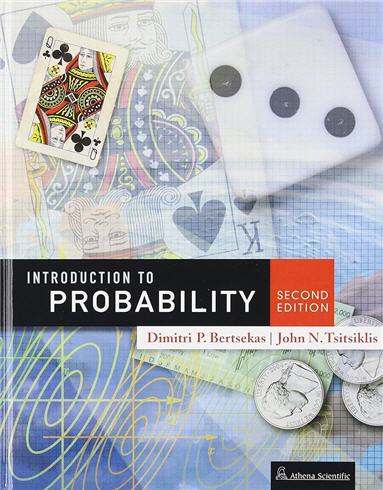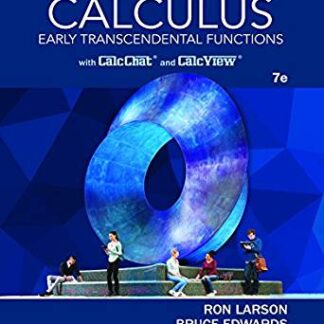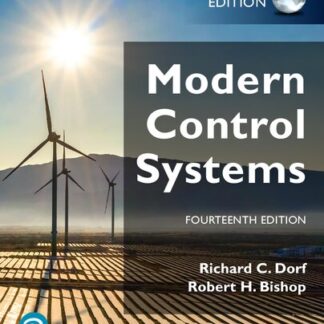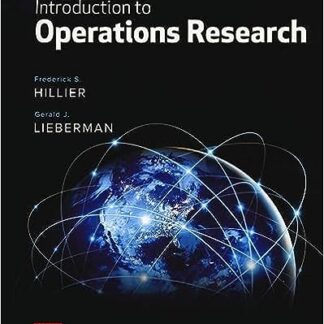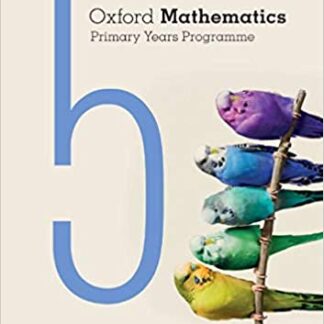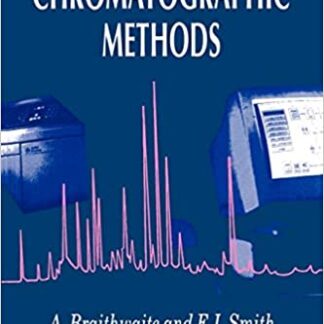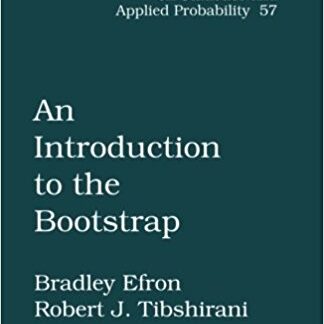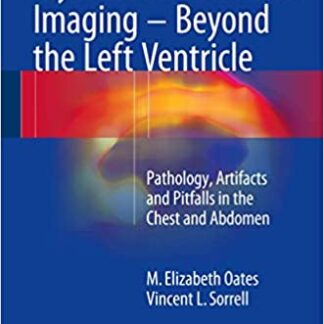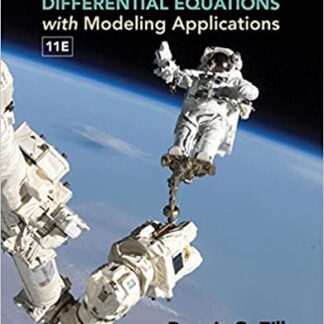Description
Introduction To Probability 2nd Edition by Dimitri P. Bertsekas, ISBN-13: 978-1886529236
[PDF eBook eTextbook] – Available Instantly
- Publisher: Athena Scientific; 2nd edition (January 1, 2008)
- Language: English
- 528 pages
- ISBN-10: 188652923X
- ISBN-13: 978-1886529236
An intuitive, yet precise introduction to probability theory, stochastic processes, and probabilistic models used in science, engineering, economics, and related fields. The 2nd edition is a substantial revision of the 1st edition, involving a reorganization of old material and the addition of new material. The length of the book has increased by about 25 percent. The main new feature of the 2nd edition is thorough introduction to Bayesian and classical statistics.
The book is the currently used textbook for “Probabilistic Systems Analysis,” an introductory probability course at the Massachusetts Institute of Technology, attended by a large number of undergraduate and graduate students. The book covers the fundamentals of probability theory (probabilistic models, discrete and continuous random variables, multiple random variables, and limit theorems), which are typically part of a first course on the subject, as well as the fundamental concepts and methods of statistical inference, both Bayesian and classical. It also contains, a number of more advanced topics, from which an instructor can choose to match the goals of a particular course. These topics include transforms, sums of random variables, a fairly detailed introduction to Bernoulli, Poisson, and Markov processes.
The book strikes a balance between simplicity in exposition and sophistication in analytical reasoning. Some of the more mathematically rigorous analysis has been just intuitively explained in the text, but is developed in detail (at the level of advanced calculus) in the numerous solved theoretical problems.
Written by two professors of the Department of Electrical Engineering and Computer Science at the Massachusetts Institute of Technology, and members of the prestigious US National Academy of Engineering, the book has been widely adopted for classroom use in introductory probability courses within the USA and abroad.
Table of Contents:
1. Sample Space and Probability
1.1 . Sets
1 . 2. Probabilistic Models
1 . 3. Conditional Probability
1 .4. Total Probability Theorem and Bayes’ Rule
1 . 5. Independence
1 .6 . Counting
1 . 7. Summary and Discussion
Problems
2. Discrete Random Variables
2.1 . Basic Concepts
2.2. Probability Mass Functions
2.3. Functions of Random Variables
2.4. Expectation, Mean, and Variance
2 .5. Joint PMFs of Multiple Random Variables
2.6. Conditioning
2 . 7. Independence
2.8. Summary and Discussion
Problems
3. General Random Variables
3 . 1 . Continuous Random Variables and PDFs
3.2. Cumulative Distribution Functions
3.3. Normal Random Variables
3 .4. Joint PDFs of Multiple Random Variables
3.5. Conditioning
3.6. The Continuous Bayes’ Rule
3.7. Summary and Discussion
Problems
4. Further Topics on Random Variables
4. 1 . Derived Distributions
4.2. Covariance and Correlation
4.3. Conditional Expectation and Variance Revisited
4.4. Transforms
4.5. Sum of a Random Number of Independent Random Variables
4.6. Summary and Discussion
Problems
5. Limit Theorems
5 . 1 . Markov and Chebyshev Inequalities
5 . 2 . The Weak Law of Large Numbers
5 . 3 . Convergence in Probability
5.4. The Central Limit Theorem
5 . 5 . The Strong Law of Large Numbers
5.6. Summary and Discussion
Problems
6. The Bernoulli and Poisson Processes
6 . 1 . The Bernoulli Process
6.2. The Poisson Process
6.3. Summary and Discussion
Problems
7. Markov Chains
7. 1 . Discrete-Time Markov Chains
7.2. Classification of States
7.3. Steady-State Behavior
7.4. Absorption Probabilities and Expected Time to Absorption
7.5. Continuous-Time Markov Chains
7.6. Summary and Discussion
Problems
8. Bayesian Statistical Inference
8. 1 . Bayesian Inference and the Posterior Distribution
8.2. Point Estimation, Hypothesis Testing, and the MAP Rule
8.3. Bayesian Least Mean Squares Estimation
8.4. Bayesian Linear Least Mean Squares Estimation
8.5. Summary and Discussion
Problems
9. Classical Statistical Inference
9. 1 . Classical Parameter Estimation
9.2. Linear Regression
9.3. Binary Hypothesis Testing
9.4. Significance Testing
9.5. Summary and Discussion
Problems
Index
Dimitri P. Bertsekas undergraduate studies were in engineering at the National Technical University of Athens, Greece. He obtained his MS in electrical engineering at the George Washington University, Wash. DC in 1969, and his Ph.D. in system science in 1971 at the Massachusetts Institute of Technology.
Dr. Bertsekas has held faculty positions with the Engineering-Economic Systems Dept., Stanford University (1971-1974) and the Electrical Engineering Dept. of the University of Illinois, Urbana (1974-1979). Since 1979 he has been teaching at the Electrical Engineering and Computer Science Department of the Massachusetts Institute of Technology (M.I.T.), where he is currently McAfee Professor of Engineering. He has held editorial positions in several journals. His research at M.I.T. spans several fields, including optimization, control, large-scale computation, and data communication networks, and is closely tied to his teaching and book authoring activities. He has written numerous research papers, and sixteen books and research monographs, several of which are used as textbooks in MIT classes.
Professor Bertsekas was awarded the INFORMS 1997 Prize for Research Excellence in the Interface Between Operations Research and Computer Science for his book “Neuro-Dynamic Programming” (co-authored with John Tsitsiklis), the 2000 Greek National Award for Operations Research, the 2001 ACC John R. Ragazzini Education Award, the 2009 INFORMS Expository Writing Award, the 2014 ACC Richard E. Bellman Control Heritage Award for “contributions to the foundations of deterministic and stochastic optimization-based methods in systems and control,” the 2014 Khachiyan Prize for Life-Time Accomplishments in Optimization, and the SIAM/MOS 2015 George B. Dantzig Prize. In 2001, he was elected to the United States National Academy of Engineering for “pioneering contributions to fundamental research, practice and education of optimization/control theory, and especially its application to data communication networks.”
Dr. Bertsekas’ recent books are “Introduction to Probability: 2nd Edition” (2008), “Convex Optimization Theory” (2009), “Dynamic Programming and Optimal Control, Vol. I, (2017), and Vol. II: Approximate Dynamic Programming” (2012), “Abstract Dynamic Programming” (2013), and “Convex Optimization Algorithms” (2015), all published by Athena Scientific.
Besides his professional activities, Professor Bertsekas is interested in travel, portrait, and landscape photography. His pictures have been exhibited on several occasions at M.I.T., and can also be accessed from his www site.
What makes us different?
• Instant Download
• Always Competitive Pricing
• 100% Privacy
• FREE Sample Available
• 24-7 LIVE Customer Support

